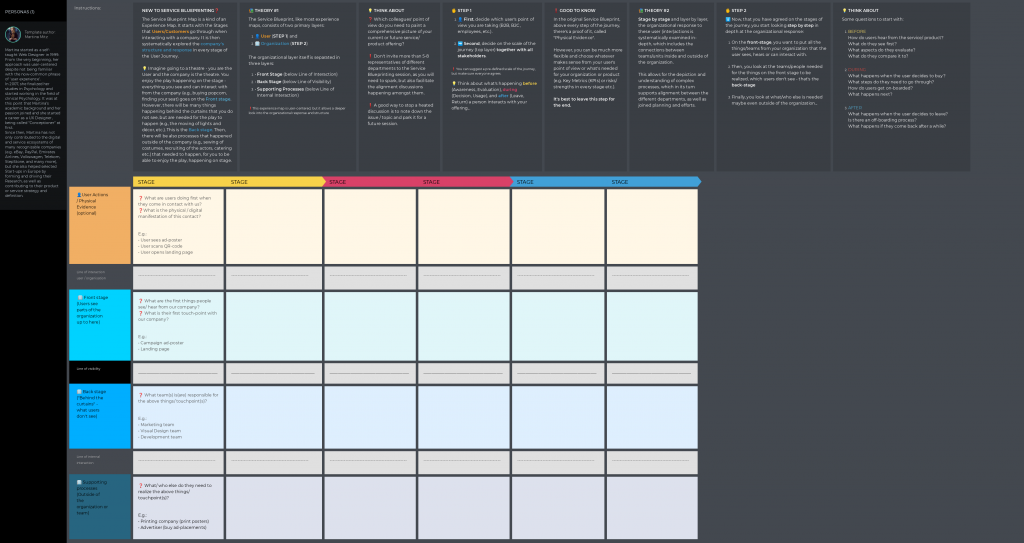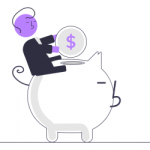There are many ways to map a service, and each can be useful, depending on the goals you are trying to achieve. A Service Blueprint, however, is one of the best methods to get a complete picture of how your service or product is delivered — end-to-end, across all channels.
To help our readers better understand what Service Blueprints are, we invited Martina Mitz, a UX psychologist with multi-year experience in building user journeys and blueprints. Throughout the span of her career, Martina has contributed to the digital and service ecosystems of many recognizable companies like eBay, Emirates Airlines, and Volkswagen. She also helped selected startups in Europe by forming and driving their research, as well as contributing to their product or service strategy.
Without further ado, read on to learn more about the matter or scroll down to the article’s end to watch a video instead.
Contents
What is a Service Blueprint?
As the name suggests, it is really a blueprint for a service. A Service Blueprint can be presented in the form of a technical drawing or a map that shows how your service works. First introduced in 1984, the term later got adapted to Service Design around the 2000s.
A Service Blueprint is an experience map, and just like other experience maps — Customer Journeys, Mental Model Diagrams, etc. — it is the ultimate big picture for complex services and offerings. Service Blueprints allow you to drill down into the interactions between users and an organization and piece the puzzle together. And since they rely on a systematic approach to gathering information from stakeholders, they help get everyone on the same page and develop a shared understanding of what is currently happening and where the problems are. By joining forces with others, you can start solving these problems or at least prepare a plan for that.
Also, blueprints help with better employee onboarding and orientation. With the help of this big picture, even most niche employees can see how their work impacts the entire user experience and get the sense that their work counts.
Let’s take a step back and look at an experience map in general. There, you will always have a user level, an organization level, and the connector level in-between, be it interactions, touchpoints, etc. And since we are user-centered, the user- or human-level always comes on top.

When we look at a Service Blueprint, it's divided by three lines that further break down the blueprint into four layers.

The first line is a no-brainer. This is the line of interaction on the connector level between the two main layers — a user layer and an organization layer. The line is punctuated to show that information or interactions can be happening both ways here.
The next line is the line of visibility on the organizational layer. This line reflects what users can actually see from the organization, as there is a lot that is happening behind the curtains and that customers do not need to know about.
There is also the layer of internal interaction. Some, but not all, employees need to know all the ways that a company functions in order to provide services to end customers.
So, it pretty much comes down to digging deeper and deeper into that organizational layer. And that leaves us with four layers on the blueprint.

On top, we have the user journey layer, where we look at a process from the users’ point of view. Then, under the line of interaction, there is the front stage of the organization. This is basically the part of the organization that customers can see and interact with. We also have the back stage that they do not see, as there are a lot of organizational activities that users don't need to know about. Also, there are supporting processes that happen in the deep or even outside of the company and that not every employee needs to know about.
If you go ahead and google “service blueprint”, you’ll see a very abstract depiction that looks something like this:

To make it a little more tangible, let’s imagine we have a client — a theater — that wants to have a look at a specific stretch of a user journey, from watching the play to leaving the theater. Of course, a lot of things are happening before that point, like choosing a play, buying a ticket, but we will focus on the "watching the play" part of the journey for our example.
What a user sees on the (front) stage is the play in its entity, with all the light and sound effects. That’s the part of the organization — a theater in our case — that a user sees. However, there is a lot happening on the back stage that a user doesn’t see, like sounds and lights moving, decoration changing, and other things that ensure a seamless experience of a theater play.
And then there are things happening outside of the theater. A tech supplier delivered all the lights, another company delivered the costumes and decor. Actors were recruited, a catering company was hired — the list goes on as we dig deeper into what is happening behind the curtains so that viewers can enjoy a cohesive play on the front stage.

Why do we need a Service Blueprint?
Most of us know that parable of six blind men who were put in front of an elephant and asked to describe it. And then, depending on the part of the elephant’s body they were touching, they all came to different conclusions — a tube, a tree, a wall, and so on. What’s more, each one of them thought that the others were dishonest because what they said did not match the experience of their own.
The moral of the story is that we all have our own point of view, and depending on it, we can see different aspects. Not only your point of view will affect the way you look at things and perceive them, but it will also influence the internal representations of the world that you build, which are called Mental Models. And we have slightly different mental models. For instance, we all know what a table is, but when asked to think of one, we all imagine it in a slightly different way.
That’s why, before we move to solving a problem, it's very important to make sure that we all start from an aligned mental model, i.e., that all stakeholders are talking about the same thing and have a shared understanding.
To align these mental models, you need to externalize them from your colleagues’ heads and bring them under one roof. Only by externalizing these models from our heads and discussing them, we can come to a shared understanding of who our users are, what their most urgent problems are, and where we can invest our efforts into solving them.
But nothing speaks louder than numbers. Below, you can see a graph from Aberdeen Strategy and Research that shows the results of polling 211 US companies regarding their experience with customer journey mapping.

We see that employee engagement increased by almost 15%, customer service costs improved by 23%, and the average sales cycle improved by almost 16%. Also, the return on marketing investments increased by almost 8%. That’s some really impressive numbers!
As Service Blueprints start with the User/Customer Journey on top, we can safely assume that the numbers apply to this kind of experience maps too.
Now that we have established that Service Blueprints and Customer Journey Maps really pay off, let’s move to the next question — how do you do that?
How to map a Service Blueprint?
This discussion wouldn’t be complete without mentioning the book “Mapping Experiences: A Complete Guide to Creating Value through Journeys, Blueprints, and Diagrams” by Jim Kalbach, the Bible for all experience maps.
Like with any UX method, a starting point is to collect input that will further inform your Service Blueprint. And a great way to do that is to conduct a workshop. There are, however, certain nuances to making your workshop effective.

Since you need mostly high-level inputs for your blueprint to start with, get high-level representatives from different departments who know the specifics of their units and have a high-level view of the company as well. That said, it’s not always the head of the department that would bring the most value to your workshop. For instance, an IT architect can sometimes give a better overview of the technical system than the head of an IT department.
The rule of thumb is to keep the number of participants from 5 to 8 and not to go overboard because you’ll be the one to facilitate the discussions in this group of high-level employees, most of whom probably have a strong voice.
Then you need to identify whose point of view you are taking. Are you going to look at the service from the point of view of a business client (B2B), a B2C customer, or even an employee?
And last but not least, once you get everyone into the room, you need to agree on the scale of the journey on top. Are you looking at your users’ entire lives and where you fit as a company? Are you looking at their day-to-day activities? Or are you looking at a user’s digital flow that starts on your homepage and ends at the checkout? It’s essential to decide on that scale as a group and commit to it throughout the entire Service Blueprint workshop. It's better to start more zoomed out, e.g., examine people's lives, rather than very focused, e.g., digital flow, as you can always take a more global step at a later stage if needed, and zoom in to create a more detailed map of it.
To sum it up, the first thing you do after getting everybody in the room is to decide who your users are — the top horizontal lane on the diagram below — and what steps or stages they go through. Then, you start peeling the onion and moving down step by step to discover what users see at each stage and who you need in the back stage, so that front stage workers can deliver whatever is needed.

The Service Blueprint is done. Now what?
Once you have prepared a Service Blueprint, the logical question is what to do with it next.

During the mapping process, you’ll come to realize a lot of pain points from users’ points of view or a lot of bottlenecks and risks from an organizational point of view. And since we are problem-solving species, your workgroup will start looking for solutions and having ideas. Your job is to note them down for further use — this is your backlog.
If your company is already bursting with too many ideas, but they are too narrow, a holistic view provided by the Service Blueprint will help prioritize them. Let product owners and marketing representatives map epics or even user stories on the blueprint so that they get the big picture and then decide, as a joint team, where to invest their efforts, depending on the results they expect.
A Service Blueprint is also a great tool to get other teams on board and help them build their strategies. From the very start, you can invite the marketing team so that they can decide how to address what’s happening on the front stage and who they need behind the curtains to achieve that. You can also include all the metrics, analytics data, and KPIs (key performance indicators) you track to see how you are doing as a business.
Case Study
To illustrate the blueprinting process, Martina has shared a case study about helping an ecommerce company revamp their retention program and increase the number of repeat customers.
The preparation for the Service Blueprint workshop was not easy — it took a month and a half for all stakeholders to find time in their calendars for a four-hour meeting. The work team included the head of e-commerce, marketing executive, business analyst, chief innovation officer, IT architect, two product owners, facilitator, and a co-facilitator.
The proposed scale was that of a typical e-commerce journey with a focus on retention.

From a user’s point of view, you first have to become aware of an offering before you can compare it to another one or something that you know already, and then you can arrive at the buying decision. Once you've bought something, most likely you will end up using it, as you have invested money and time in it. And if you are a returning customer, after some time you come back to the product or service and want to use it again.
These are high-level stages that you can easily get out of your colleagues, no need for extensive user research here. We prepared the digital flow of the checkout process only to illustrate that it was a wider context, which we were going to examine by looking at what was happening before and after people entered our website.
To make the workshop as efficient as possible and handle all the heated discussions, we had a lot of snacks. But on a more serious note, in addition to a facilitator, we also had an assistant who helped with transcribing activities, which is highly recommended because a facilitator needs to remain an active part of the discussion. It is also great if the co-facilitator is a more junior colleague, as this is a great opportunity for them to learn first hand.
Another tip that helped get better results was the use of storytelling to translate from digital to real life. For example, the typical flow was that a user chooses an offering, gives their credit card information, checks out, and the company confirms the order and thanks them. And when that user comes back, the company doesn’t greet them until they get to the credit card page.
With a bit of storytelling, we can translate this flow into a real-life brick-and-mortar store experience to illustrate what an unpleasant User Experience that would be: imagine you walk into a store looking for something. You invest your time and brain in finding the "right thing". Finally, at the cash register, you are greeted by name while you give your credit card to complete the purchase. What a nice ending of this journey!
But imagine, the next day, when you visit the store again, the same sales assistant won’t bother to come to help you, and the same cashier doesn’t even recognize you. You greet the cashier, but they are stone-faced. You start feeling really awkward. But then you pull out your credit card and the cashier suddenly recognizes you and starts acting very nice. Chances are that is the last time you bought something in this store, right?
This kind of storytelling and metaphors helped reveal blind spots and get a clearer view of the many and partially complex reasons why customers did not want to come back.
During the first session, which took us a month and a half to schedule and four hours to conduct, we didn’t manage to complete the entire Service Blueprint. However, the stakeholders saw the immense value behind it, so this time it only took them about a week to schedule the next four-hour session. What’s more, by the next session the company already managed to improve workflows and streamline internal processes based just on the discussions and realizations from the first workshop. As the cherry on top, the head of ecommerce was promoted to program director.
After the second workshop, the Service Blueprint looked like this:

The black rectangles were the stages. The yellow notes below were the front stage and darker yellow — the back stage, while the orange notes depicted the supporting processes. We also added pain points — red notes — that became clear during the discussion. And finally the green notes, which were the ideas that those pain points and the various discussions inspired.
However, the most amazing thing was that the stakeholders decided to put promises they make to customers on top of every stage to monitor whether they deliver on those promises and what can be done to improve — blue and magenta notes. This demonstrated a big shift in the stakeholders’ mindset, from campaigns, conversions, KPIs, and so on to being truly user-centered.
The bottom line
To wrap up our discussion for today, let’s circle back to the many birds, a.k.a. benefits of a Service Blueprint mentioned in the title and see what they are:
- User-centered mindset. Few other methods can realign or completely change a company mindset as fast as a Service Blueprint. Remember the use case and the exciting changes that happened within a week?
- Shared understanding. When you work on building a Service Blueprint, this also creates a common understanding amongst the stakeholders, who usually consider their part of the company to be the most important. Because of this common ground, it quickly becomes clear what the company’s priorities are and what the next steps could be, etc.
- Orientation. Once you have this common ground and a shared understanding of the company’s priorities, it’s also easy to see the individual responsibilities and where there is an overlap. This helps to ensure better collaboration and leads to improved results.
- Dynamics. Since different people from different departments participate in the workshop, this can help the facilitator understand the company's dynamics much faster.
- Stakeholder success. Last but not least, all the positive changes that can come from a Service Blueprint mapping, ultimately underpin the success of stakeholders.
The video
Want to see (and hear) everything about service blueprinting directly from Martina? Watch a recording of a past event with her.
The template
Now you know enough about this type of experience map and you are ready to create your own. To help you with that, in collaboration with Martina we prepared a ready-to-go template you see below.

What are you waiting for?






Good overview. I first started this work about 1991 working for the post office in New Zealand. I happen to find a great book that introduced service blueprinting and related tools, Service breakthroughs: Changing the rules of the game, by James Heskett, W. Earl sasser Jr., and Christopher Hart. We used or developed concepts like UX and human-centered problem solving as it seemed important. It was highly useful for shaping services that created value for our customers.
That’s really impressive. It may seem that service blueprinting and the concept of customer journey mapping appeared only recently, that 20-30 years ago sellers and developers were focused only on their products and services, but you are a living proof of the opposite. Thank you for sharing, Ed!
I was wondering how to make a service blueprint and I came across this article. Thank you for breaking down the methodology and highlighting its benefits. Will try convincing my colleagues to do a workshop on it.
In the service blueprint example, Martina says it was hard to hold a workshop with the stakeholders because everyone had busy schedules. But our problem is in explaining to other departments we need a workshop like that at all. Do you have any tips on that?
Hi Ernie, good question! We have a blog post on how to get stakeholder buy-in for journey mapping initiatives. The proposed methods would also work well for a service blueprint workshop. Here’s a link: https://uxpressia.com/blog/journey-mapping-initiative
I came across a service blueprint as a UX improvement method a while ago, but didn’t fully appreciate its value until I watched the video with Martina. It’s interesting to see how she highlights psychological aspects in examples and explanations. Thanks!